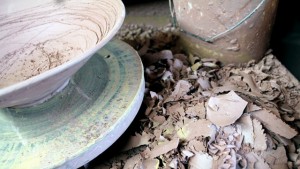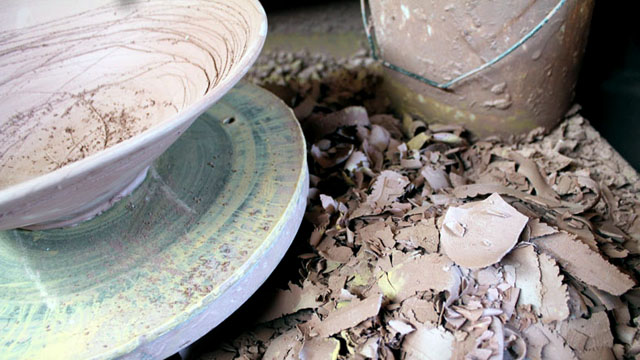View Clay Minerals in a larger map
 Clay minerals found naturally in soils around the U.S. and world form the three main types of clay used in pottery: porcelain, earthenware, and stoneware. A unique combination of the minerals kaolin, illite, chlorite, sepiolite, and smectite are collected into each ball of clay to determine the type, glaze, structure and color used in a single piece of pottery.
Clay minerals found naturally in soils around the U.S. and world form the three main types of clay used in pottery: porcelain, earthenware, and stoneware. A unique combination of the minerals kaolin, illite, chlorite, sepiolite, and smectite are collected into each ball of clay to determine the type, glaze, structure and color used in a single piece of pottery.
Potters base their mixture of clay on the plasticity of each material. Plasticity is “the ability to undergo deformation without cracking.” The easiest way to determine a clay’s plasticity is using the “coil” test where a sample of clay is taken, rolled into a coil, and tested for its deformability. The chemical make-up in each clay mineral determines the particle size, permeability, and firing temperature for a piece of pottery. Between the five main minerals found in clay, kaolinite is the most common.
Kaolinite holds the chemical composition Al2Si2O5(OH)4 and is an aluminum silicate material with a low “shrink-swell” capacity. It is a soft, white mineral but is often colored orange or red by iron oxide found in the soil. Kaolinite is found all over the country and is the most common clay in the Mountain and Piedmont regions of North Carolina. It is the most prominent mineral found in kaolin, or porcelain, pottery.
Illite is a white clay mineral that was first discovered in Calhoun County, Illinois. Its composition is (K,H3O)(Al,Mg,Fe)2(Si,Al)4O10[(OH)2,(H2O)]. Illite has an absence of swelling due to its tightly interlaced molecular spacing. It is a common mineral found in sediments, soils, and metamorphic rock.
